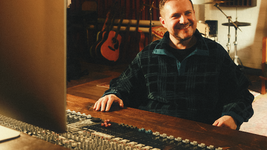The Limits of Freedom: Reviewing Shilpa Gupta's Sun at Night exhibition
- Maisie Allen
- Nov 8, 2021
- 4 min read
Set in the Barbican Centre’s intimate Curve Gallery, Mumbai-based artist Shilpa Gupta centres her first major London exhibition, Sun at Night, around themes of freedom of expression and what it means to be confined in one’s own space. Whilst not definitively linked to the Covid-19 pandemic and more shining a light on the plight of political prisoners, the smaller spaces of the Curve allude to the social claustrophobia exacerbated by the pandemic; another cause of great suffering for many.
At the entrance to the space, Gupta greets the viewer with two motion flapboards, entitled StilltheyknowwhatIdream, with their transport connotations amplifying the vastness of language and culture, as she interrupts the viewing to create messages that show a dialogue between the two boards. Ranging in expressions from ‘I Love You’ to ‘Let’s Go for a Walk’, Gupta sculpts and manipulates these expressions to highlight the fragility of language and invites us to reflect on our own use of words.

Shilpa Gupta: Sun at Night
Installation view
The Curve, Barbican Centre
7 October 2021 – 6 February 2022
© Tim Whitby / Getty Images
The poignance of this particular exhibition is hard to escape in the Curve, where Gupta has scattered fine line drawings, with printed poems and quotes from prominent activists and those who have been imprisoned by their state, such as Nigerian writer Wole Soyinka hidden amongst her slightly smaller sculptures. The range of materials used by Gupta for Sun at Night from gun metal to pencil leads all work to encapsulate the fragility of freedom; freedom to speak, to write, and to protest.
Paying homage to activists and political prisoners, Gupta interlocked a copy of poems by the Malawian poet and writer Jack Mapanje and a memoir by Turkish novelist Orhan Kenal, in which both texts refer to their own incarceration. The frequent references to texts by these activists and others just like them is key to understanding Sun at Night, as Gupta uses her artistic platform to highlight the words of others, many of whom are still voiceless and powerless against systems of oppression they are attempting to overthrow.
Using poetry as a primary focus in this exhibition, Gupta brings an interdisciplinary feel to her work, capturing the poems of protest and resistance from Yannis Ritsos, Anna Barkova, and Osip Mandelstam, among others, who have been referenced previously in glass bottles in Untitled (Spoken Poem in a Bottle), which has been ongoing for Gupta since 2018. The sealing of these words by Gupta allows her to create a statement that evokes a sense of awe from the viewer, experiencing the power of poetry and art as a form of political expression in ways not afforded often by a mainstream society.

Shilpa Gupta: Sun at Night
Installation view
The Curve, Barbican Centre
7 October 2021 – 6 February 2022
© Tim Whitby / Getty Images
Highlighting the words of activists often hidden in the shadows’ of nations’ conflicts is what serves as the core foundation for Sun at Night, and is its dramatic climax in the sound installation of For, In Your Tongue, I Cannot Fit. In a separate room in the Curve, Gupta has installed 100 speakers, microphones, printed text, and metal stands in which the viewer is immersed in darkness, confronted with fragmented lines of poetry, with each one coming from a different place. This is echoed by the other ninety-nine speakers, creating a haunting chorus of dissidence that spans several languages, countries, and causes.
The scattered nature of each piece in the Curve allows each viewer to construct their own narrative of Gupta’s exhibition, allowing space for both pessimism of the state’s actions and horror at human rights in crisis, but also for a sense of hope that the world is slowly beginning to change. This idea of movement, as if the world is slowly turning on its axis towards a brighter future, built on those who sacrificed their freedom for it, is keenly explored across the rest of the exhibition as well. In the 2021 piece, Untitled (Distance Between Two Tears), Gupta creates a minimalist sculptural form which measures the distance between her eyes, that is her tears. Measuring the distance of one’s tears brings a heightened sense of sorrow to Gupta’s exhibition, in a sense that change cannot occur without tragedy or personal sacrifice; it hints towards a collective mourning of those who have been lost in the midst of protest.

Shilpa Gupta: Sun at Night
Installation view
The Curve, Barbican Centre
7 October 2021 – 6 February 2022
© Tim Whitby / Getty Images
The gradual intensity of Sun at Night is what allows it to be so evocative for the viewer, creating an immersive experience that is brought together by rallying cries for change in several different forms. From her more traditional sculptures, cast in gunmetal, aluminium, and steel, to line drawings of hidden figures and a climactic sound installation, Gupta plays with the sensory ideas of what it means to discover the meaning behind art. The fragments of her work hidden in corners of the Curve encourage the viewer to ask for more from the world in front of them, and pay homage to those who have changed it before them and the sacrifices they made to get there.
Gupta does not hide behind abstraction in this exhibition, instead explicitly uses the words of political prisoners and activists in order for each viewer to take accountability for the role they too play in structures of oppression that sweep across the globe and into every society. The starkness allows lives to be laid bare, in a haunting installation that makes for an extraordinary UK debut.
Sun at Night is in the Barbican's Curve Gallery until the 6th February 2022 and no advance booking is required with free admission. You can find out more information here and you can follow Shilpa Gupta's work on her website.
Written and edited by Maisie Allen, Literature Editor.


































Kommentare